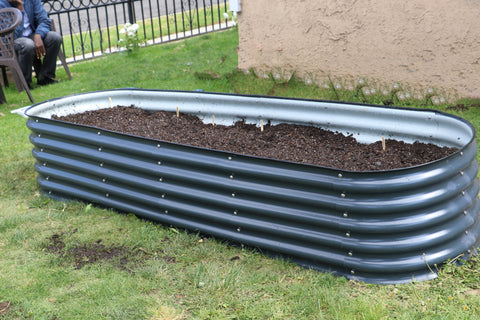Tips from Olle Garden Bed: How to Use Fall Leaves (Leaf Mold) to Improve Garden Soil
Autumn is such a beautiful season of the year: clean and cool air, the last flowers, and the short and amazing light of autumn leaves. Then they all turn brown and fall to the ground. It looks beautiful at first, then it becomes annoying. This seems to be a waste - the streets are lined with huge garbage bags full of dry leaves. But that's all. Don't waste fallen leaves, because they can become a useful supplement to the garden. The following content also has some reference value for raised garden beds.
It is easy to turn dry leaves into wonderful mulch and soil conditioner for the garden. Chopped leaves or leaf molds can be mixed into the soil to loosen the heavy clay, or you can smear it like a cover. It can be added to the container mixture of outdoor potted plants. The container dries so quickly, but the leaf mold helps keep the water.

What is leaf mold?
Leaf mold is made from chopped leaves and forms a carbon rich covering that improves soil texture and increases water retention. Leaf mold becomes soil for new or old gardens, helping to break down heavy clay and loosen sandy soil.
Leaf mold has a pleasant fragrance and has free additional benefits! If you don't have many trees on your property, most neighbors will be happy to let you take their trees. Creating leaf mold is a sustainable approach that can reduce waste and water use.
Chopped leaves are not only useful, but also the size of the pile of leaves is greatly reduced. Once torn up, it is amazing how a huge heap can be reduced to such a small number. You can build a pile of broken leaves and decompose them into fine textured materials, which are very useful in new or established gardens. You can also add it to an existing compost heap.
Rake the leaves into low piles.
Remove large sticks and debris.
Run the mower on the leaves until they are chopped.
Wet the pile. Don't let it get wet. A wet pile will decompose faster than a dry pile.
About once a week, you will be ready to use the leaf mold in the garden within six months. If you do not want to inflate the pile every week, it will take longer.
Leaf mold does not need to be heated like ordinary compost. Even if the compost does become hot, it may contain weed seeds. On the other hand, leaf molds do not contain weeds, so they will not be introduced into your garden.
Deciduous leaves kill grass and attract insects
Leaves left on the lawn will form a dense, damp mat, which will not only become ugly, but also kill the grass. Some leaves, such as oak leaves, are large and hard and decompose very slowly.
If you don't want to rake leaves from the lawn, use an ordinary lawn mower or a cover mower to cut them into fine pieces. Chopped leaves break down quickly and promote beneficial fungi and earthworms. A small amount of chopped leaves can be left on the lawn if they are very finely chopped.
A large piece of dry leaves, even if they are cut up, may be too many to stay on the lawn. In this case, use a lawn mower with bags to collect leaf fragments and form leaf mold.
Don't leave the whole leaf in the garden. Large leaves encourage insects. Rake the leaves from the garden in late autumn and all winter. Some trees do not shed all their leaves until early spring, so they need to rake again.

Leaf Mold Tips
Bagging: If you don't want a pile of chopped leaves, you can put them into the garbage bag. Pierce the bag and add a shovel full of soil. Sprinkle a little water into the bag. Stir at regular intervals to speed up the decomposition process.
Use an old trash can: A large trash can can be used in the same way. Perforate the sides of the can, wet and inflate.
Corral it: build a small cage. Use four posts (one at each corner) and wrap chicken shreds around the pen. Fill it with chopped leaves, moisten it, and occasionally inflate it.
Compost leaves: Use bagged or stacked leaf molds in compost bins. Leaf mold is a brown substance. Layer with green material, such as the last grass of the season.
Rhododendron food: Add needles before cutting leaves. Pine trees and other coniferous trees form acidic mulch, which is very suitable for azalea, azalea and other plants that like acidic soil
Leaf mold coverage: When adding leaf mold in the garden, do not crowd the plants. Lay 2-3 inch layers on the garden to avoid plant crowns and stems.
Avoid black walnut leaves: they contain a chemical called walnut, which can inhibit seed germination and nutrient absorption of flowers, vegetables, some trees and shrubs.
Avoid the leaves of diseased trees or pests.
